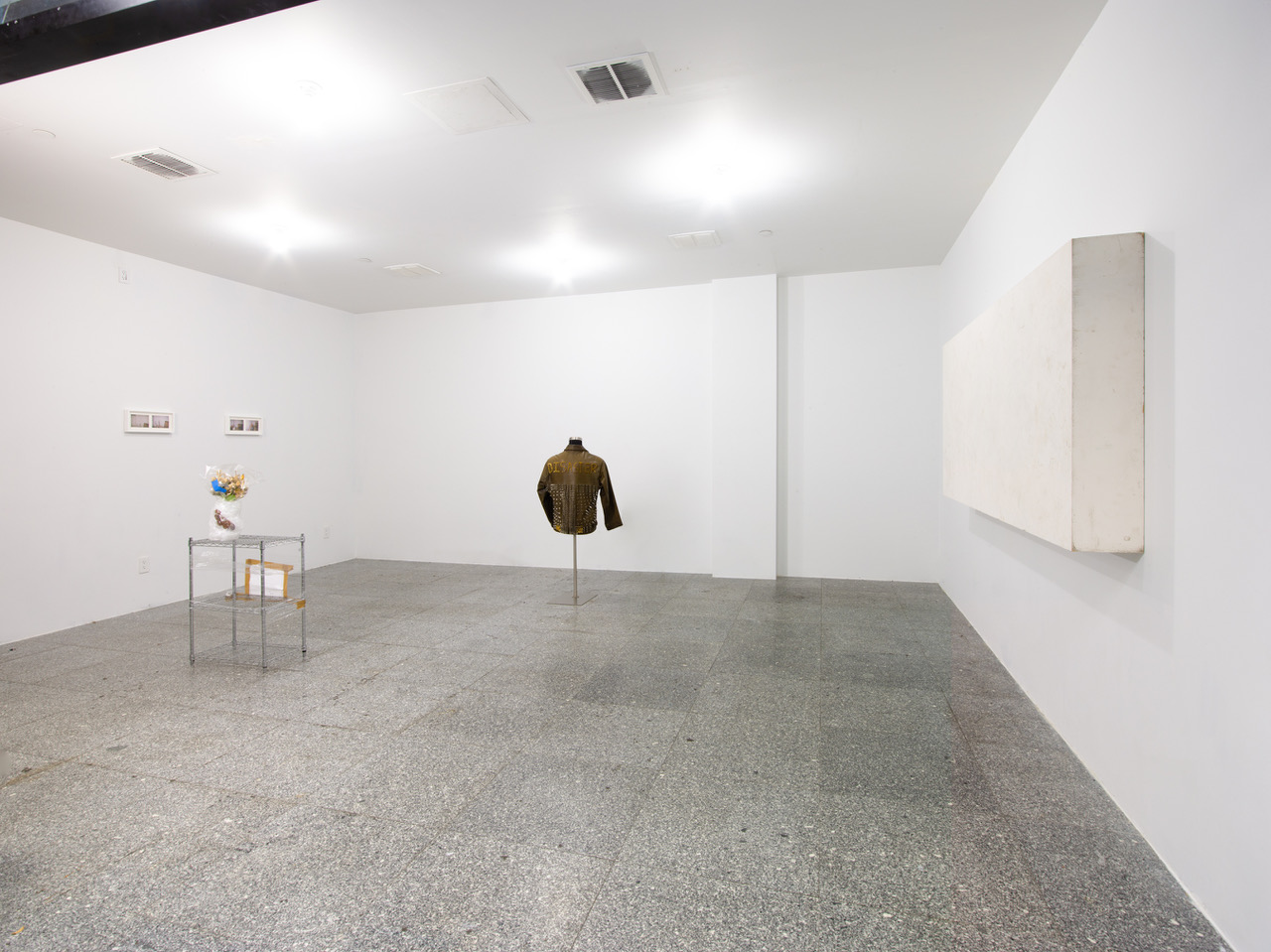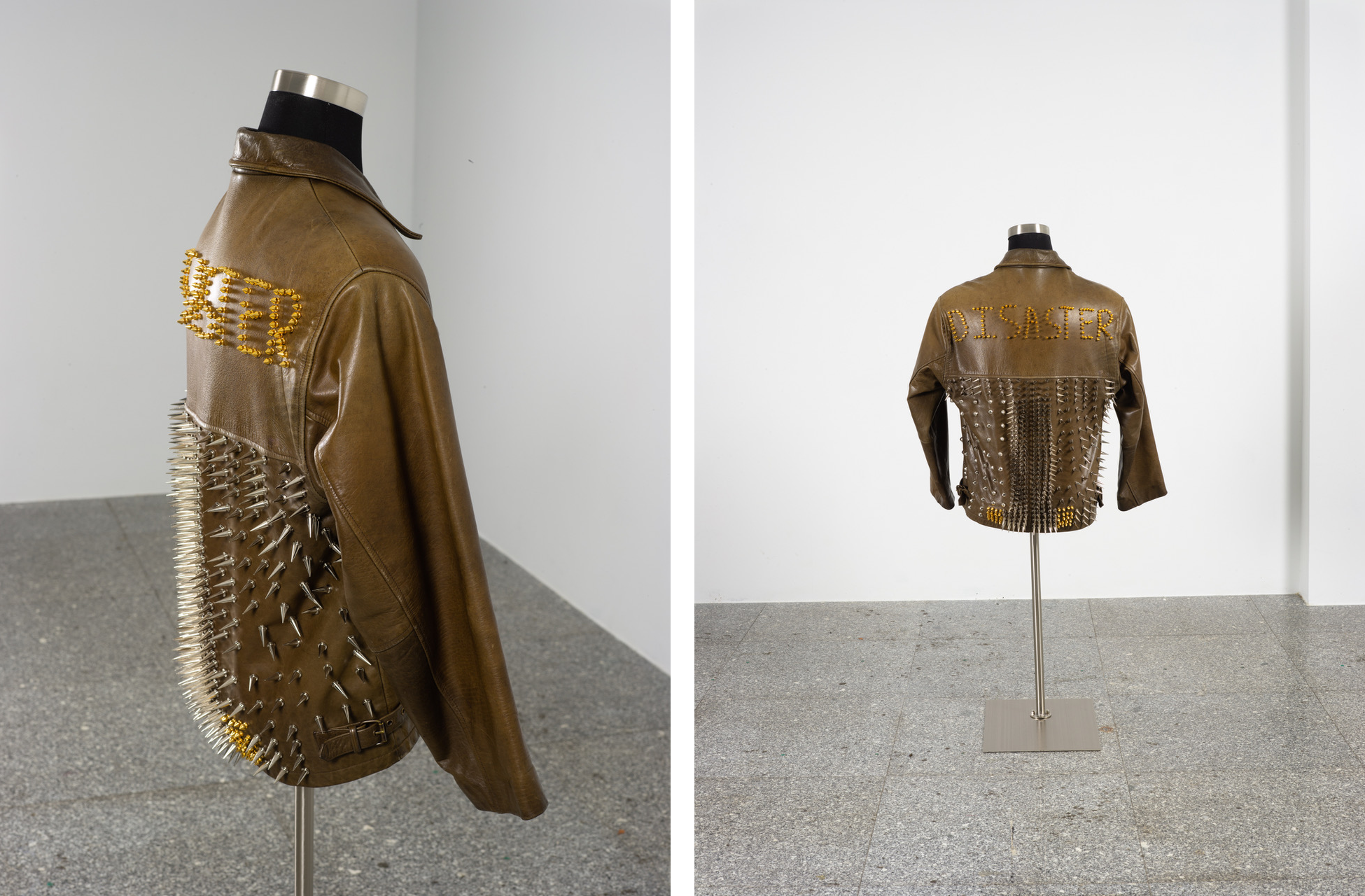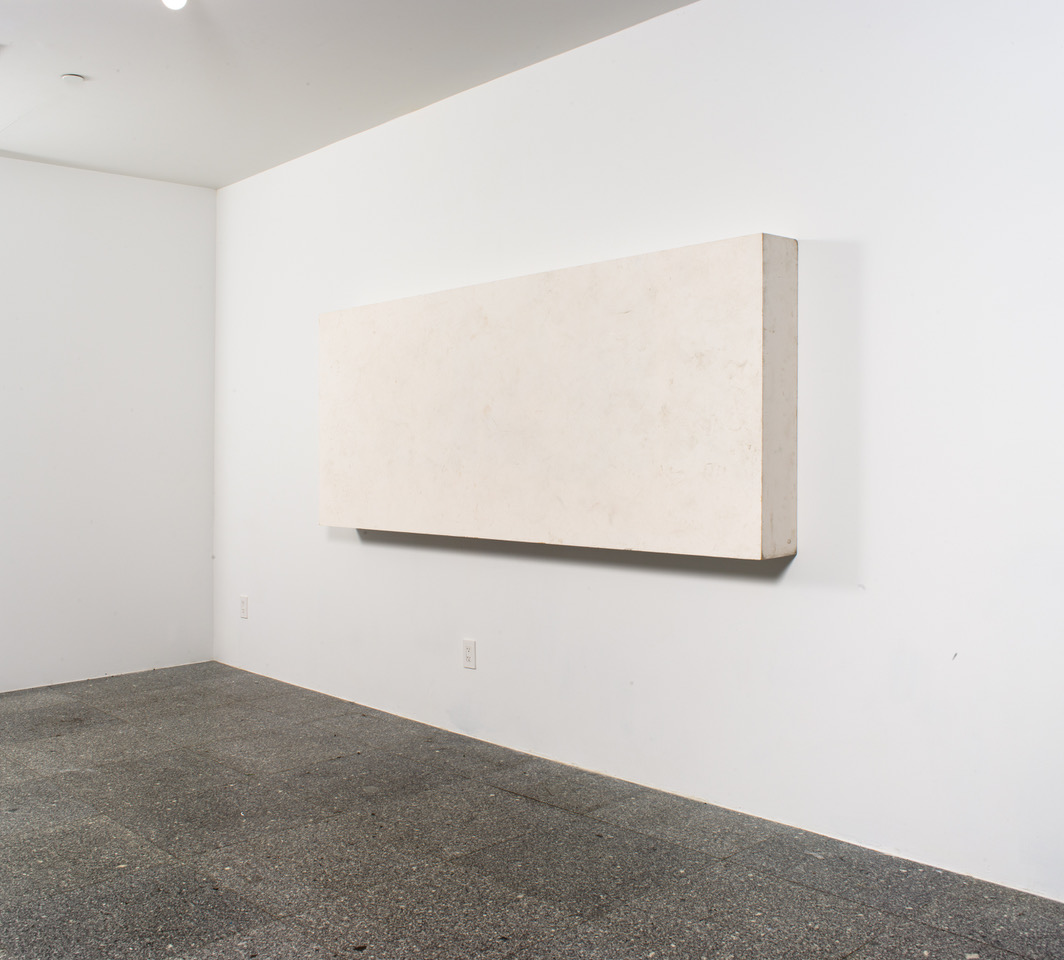Three Works, the title of Elliot Reed’s exhibition at OCD Chinatown in New York, is a deceit. The show contains five discrete works; the press release comprises two long strings of words. Reed’s background is rooted in music and performance, and this show marks only the second time that he has presented static objects. These objects are also remnants, having lived previous lives during his residency at the Studio Museum in Harlem and then brought into action again at MoMA PS1, before being placed in storage—a moment that is captured in a pair of photographs in the show. Reed and Laura Brown met in the gallery space located on the labyrinthian top floor of a mall.

Elliot Reed, Concrete, 2020–21. Flowers, metal shelf, paper, cellophane, ink, 23 1/4 x 13 1/2 x 39 in. Installation view and detail. Courtesy of the artist and OCD Chinatown, New York. Photos: Jason Mandella.
Elliot Reed: What led me to this show was thinking about what it means to perform without a performer present. What are different ways I can use the codes of my life practice and the embodied way that I’m used to working, and translate that into objects? How to make something seem really fleshy, really live, without showing my physical self? Now I’m able to use performance not just as a medium but as a tool—and to use objects and performance together, for the logic of liveness to speak through things. This room is definitely full of ghosts—the ghost of my body and the ghosts of other people’s bodies.
Laura Brown: Tell me about the dead flowers.
ER: This piece is called Concrete (2020–21). These flowers have been transported between four different locations. They were given to me right before lockdown started in March 2020. I had them wrapped up, moved to my new studio in Long Island City. Then they went into storage in Two Bridges in Manhattan. The whole time they stayed on this shelf that they’re sitting on now. After having been locked out of my studio for so long, going in there I had this immediate connection and relationship to the way that these objects were arranged in the space. I made the executive decision: this is the work.
LB: This is it. The pair of photographs titled Untitled (Legs) (2021) seem to deliver the actual first-person view of that moment as well.
ER: I was thinking of performing with the camera, using my body to collect an image as an extension of my eye or my arm. I’ve been referring to these two images side-by-side as the world’s shortest short film.

Elliot Reed, Untitled (Legs), 2021. Framed set of two matte photographic prints, 16 x 7 in. Courtesy of the artist and OCD Chinatown, New York. Photo: Jason Mandella.
LB: They also share the same proportions as the work on the facing wall. Although titled Drawing (2019–21), it was previously a platform on the floor that now hangs on the wall. I was looking at that work like a painting, but it didn’t feel right. Even though it has that presence on the wall.
ER: It’s kind of a visual pun in that way. It’s also supposed to be filmic, like a widescreen. Drawing contains a duration: I was working on it from 2019 to 2021. Its original life was as a plinth. I was doing a series of performances, choreographies, movements, gestures on it—all these things that normally happen in real time then disappear into the ether, particularly when there’s no viewer. Instead, every little mark, boot print, or smear of indigo from my jeans became this ab-ex-inspired drawing on the plinth, an image of the things that are normally invisible.
LB: Can you tell me about where writing comes in? Framing the show, you have this list of words: the twenty-four layers and thirty-two tensions in the work.
ER: This was formed in collaboration with the writer David Coleman. After the show was done, we had conversations and recorded everything. He crystallized the words. Something that he picked up on is that the show is filled with tensions and this sense of transformation. Versus something that’s maybe more directly representational or even directly narrative, this turning or twisting is the narrative.

Three Works, installation view, OCD Chinatown, New York, March 25–May 10, 2021. Courtesy of the artist and OCD Chinatown, New York. Photo: Jason Mandella.
LB: The gold hex spikes you used for the jacket in Sheath (2021) are on the materials list. But I didn’t know what “hex spike” meant at first and I read something else into it. I was thinking the word hex could be on that list of layers.
ER: Definitely. The jacket’s spikiness is giving a “stay back” energy. Its title, Sheath, is a thing that’s meant to cover, to protect, but it also points to the fact that it’s literally the skin of an animal that had its own history, and it took a bit of my history when I was wearing it, too. Now it’s calcified as a sculpture.
LB: But it’s not the end of the object. I suppose an art object can have an end date and still be living in the world. Beyond the materials, all of this seems equally to be part of its formation as an artwork.
ER: Totally. I’ve done this little thing with the scale of it, to assert it in this space as a sculpture: the stand I chose to display it on is at a height that’s too low to signify a person, so it’s removed from the context of being displayed to be worn, like in a store. It’s also very heavy, so it’s not too fun to wear. But it did come from my closet.
LB: As it is now?
ER: I studded it. The “DISASTER” text and all of the spikes were a hand-worked transformation to turn this into a sculpture.

Elliot Reed, Sheath, 2021. Hand-studded leather jacket, 24k gold hex spikes, brass studs, display stand, 3 1/2 x 1 1/2 x 4 ft. Detail and installation view. Courtesy of the artist and OCD Chinatown, New York. Photos: Jason Mandella.
LB: Why “DISASTER”?
ER: “DISASTER” is a very id word to me. It’s maybe a bit foolhardy and a bit masculine in some ways, but I’m also thinking of the feminine, constructive side of it, too.
LB: It’s very melodramatic, which is also a bit funny somehow. In this space, what’s the disaster? The dead flowers, maybe?
ER: It’s this deflated spectacle, right? What happens when someone finally finds the gallery and comes to the show and sees this. Like, is it broken? Are you open? Some of the humor for me is that, in this all-white space, the work is rather quiet. But it’s also facetious in its quietness. It’s pretending to be really minimal, but it’s actually quite human. So much care and intentionality and communication were required in order to keep these dry flowers intact. There’s no wire, no resin.
LB: In the past you’ve talked about performance as a space to aestheticize imperfection.
ER: I used to think of myself as a perfectionist, but I’m really just extremely meticulous. I think memory and place are the most imperfect things of all. It’s impossible, maybe, to hold a space or a period in time. All of these works are made by reaching toward catching some of that.

Elliot Reed, Drawing, 2019–21. Wood, latex paint, indigo, sweat, rubber, blood, saliva, dirt, Velcro, approximately 4 x 9 ft. Courtesy of the artist and OCD Chinatown, New York. Photo: Jason Mandella.
I love how all-encompassing but also utterly useless language can be. Knowledge is what happens, I guess, when you have a word to describe a thing. Because we’re inhabiting the same world but are limited to our own experiences, it’s only when you have a word to describe something that you can hold it. The space between experiencing and knowing, to me, feels like the most sublime type of imperfection. Having something in your heart or in your flesh that’s so real, but maybe you can’t say what it is or you can’t have that experience reflected back to you—that’s an imperfection, an incomplete loop or an unclosed circle, but also a space of potential.
LB: And your work is an attempt at closing that loop? The encounter you’re describing is applicable to this show of objects, too—as being in real time, because they are.
ER: It’s an attempt that feels radically honest to me. I have nothing else to give. x

Elliot Reed is a 2019 danceWEB scholar, 2019–20 Artist in Residence at The Studio Museum in Harlem, and recipient of the 2019 Rema Hort Mann Emerging Artist Grant. Exhibitions include a commission with JACK Quartet (2021), Metro Pictures (2021), MoMA PS1 (2020/21), OCD Chinatown (2021), The Getty Center (2018), Hammer Museum (2016), Dorothy Chandler Pavilion (2018), The Broad (2017), and performances in Tokyo, Osaka, London, Mexico City, Vienna, and Hamburg. His next show opens Fall 2021 at Kunsthaus Glarus.
Laura Brown is a writer, curator, and editor living in New York.